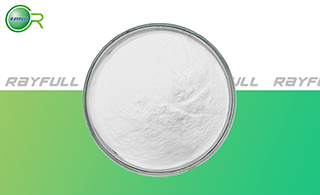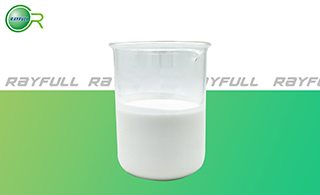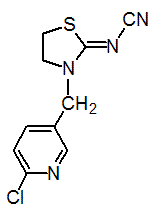THIACLOPRID



 噻虫啉
噻虫啉
Introduction: Thiacloprid is a high selective carbamate insecticide with stomach and ovicidal action. Thiacloprid is chloronicotinyl insecticide for use on apples, pears, some citrus crops, brussel sprouts, cabbage, cauliflower, carrot, parsnip, peas, potato, oilseed rape to control sucking and chewing insects such as aphids, pollen beetles, blossom midge, codling moth.
Common name: Thiacloprid
Another name: Calypso, (Z)-thiacloprid,
Chemical name: (Z)-3-(6-chloro-3-pyridylmethyl)-1,3-thiazolidin-2-ylidenecyanamide
Empirical formula: C10H9ClN4S
Structural formula:

Mol. Weight: 252.72 g/mol
CAS No.: 111988-49-9
Specifications
Leading Thiacloprid supplier
Thiacloprid 240 g/L SC
Thiacloprid 450 g/L SC
Thiacloprid 480 g/L SC
Thiacloprid 95% TC
Packing:
BULK PACKING
Solid: 25KG/Bag, 25KG/Drum, 50KG/Drum etc.
Liquid: 200L/Drum, 20L/Drum, 10L/Drum ect.
SMALL PACKING
Solid: 1kg/Alu bag, 500g/Alu bag, 200g/Alu bag, 100g/Alu bag, 50g/Alu bag, 15g/Alu bag etc.
Liquid: 5L/Drum, 1L/Bottle, 500ml/Bottle, 250ml/Bottle, 100ml/Bottle, 50ml/Bottle etc.
Customerized packing label
Thiacloprid FAO standard
Professional registration
HAZARDS IDENTIFICATION
Hazard statement(s)
H301: Toxic if swallowed.
H332: Harmful if inhaled.
H336: May cause drowsiness or dizziness.
H351: Suspected of causing cancer.
H360: May damage fertility; May damage the unborn child.
H400: Very toxic to aquatic life.
H410: Very toxic to aquatic life with long lasting effects.
Precautionary statement(s)
P201: Obtain special instructions before use.
P202: Do not handle until all safety precautions have been read and understood.
P261: Avoid breathing dust/fume/gas/mist/vapors/spray.
P264: Wash ... thoroughly after handling.
P270: Do not eat, drink or smoke when using this product.
P271: Use only outdoors or in a well-ventilated area.
P273: Avoid release to the environment.
P281: Use personal protective equipment as required.
P304+P312: IF INHALED: Call a POISON CENTER/doctor/... if you feel unwell.
P304+P340: IF INHALED: Remove person to fresh air and keep comfortable for breathing.
P308+P313: IF exposed or concerned: Get medical advice/attention.
P312: Call a POISON CENTER or doctor/... if you feel unwell.
P321: Specific treatment (see ... on this label).
P330: Rinse mouth.
P391: Collect spillage.
P403+P233: Store in a well-ventilated place. Keep container tightly closed.
P405: Store locked up.
P501: Dispose of contents/container to ...
Supplemental Hazard Statements: none
MAMMALIAN TOXICOLOGY
Acute toxicity: 1) Acute oral LD50 for rat: 444 a.i.mg/kg. 2) Acute dermal LD50 for rat: >2000 a.i.mg/kg. 3) Inhalation LC50 (4 h) for rat: >0.481 a.i. mg/L. 4) Non- irritating to skin (rabbits). 5) Non- irritating to eyes (rabbits). 6) Not a skin sensitiser (guinea pigs). NOAEL for rats (chronic toxicity, carcinogenicity) is 25 ppm. No primary carcinogenic potential; no primary developmental toxicity in rats and rabbits; no evidence of a genotoxic or mutagenic potential.
ADI (JMPR): 0.01 mg/kg b.w./day [2006]
Classification:
Toxicity class WHO (a.i.): II (Moderately hazardous)
EC Risk Classification: Xn - Harmful: R20/22; N - Dangerous for the environment: R52/53
ECOTOXICOLOGY
Effect on birds: high toxicity to birds, acute oral LD50 for Japanese quail is 49 a.i. mg/kg. Effect on fish: moderate toxicity to fish, acute 96 hour LC50 for Rainbow trout is 24.5 a.i.mg/L. Effect on aquatic invertebrates: moderate toxicity to aquatic invertebrates, acute 48 hour EC50 for Daphnia magna is 85.1 a.i.mg/L. Effect on algae: low toxicity to algae, acute 72 hour EC50 for Raphidocelis subcapitata is 60.6 a.i.mg/L. Effect on honeybees: moderate toxicity to honeybees, contact acute 48 hour LD50 is 38.82 a.i.μg/bee, oral acute 48 hour LD50 is 17.32 a.i.μg/bee. Effect on earthworms: moderate toxicity to earthworms, acute 14 day LC50 is 105 a.i.mg/kg.







